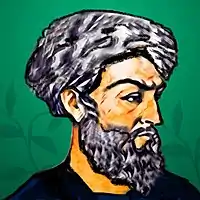Abu al-Abbas al-Nabati
Ahmad bin Muhammad bin Mufarraj bin Ani al-Khalil, better known as Abu al-Abbas al-Nabati, Ibn al-Rumiya or al-Ashshab,[1] (Arabic: أبو العباس النباتي, Abu’l-ʿAbbās al-Nabātī) (c. 1200) was an Andalusian scientist, botanist, pharmacist and theologian. He is noted for introducing the experimental scientific method in the area of materia medica.[2] His techniques such as separating verified and unverified reports led to the development of the field of pharmacology. He was a teacher of fellow Andalusian botanist Ibn al-Baitar.[3][4][5][6][7]
Abu al-Abbas al-Nabati | |
|---|---|
 Illustration of botanist Abual-Abbás al-Nabati. | |
| Born | 1166 |
| Died | 1239 |
| Nationality | Andalusian |
| Known for | Scientific classification |
| Scientific career | |
| Fields | Botanist, Scientist, Pharmacist, Jurist |
| Influences | Pedanius Dioscorides, Ibn Hazm |
| Influenced | Ibn al-Baitar |
Life
Though often referred to by multiple nicknames, Nabati's birth name was Ahmad bin Muhammad bin Mufarrij bin Abdillah. Nabati was a descendant of freed slaves, and the nickname Ibn al-Rumiyah[8] or "son of the Roman woman" was due to his Byzantine Greek ethnicity, a fact which was said to cause Nabati a measure of embarrassment.[9]
Born in Seville, Spain in 1166,[9] Nabati traveled to North Africa, the Levant and Iraq while pursuing his education, eventually spending a period in Alexandria in 1216.[10] He later returned to Seville and opened a pharmacy.[11]
Nabati was also a theologian. Though he initially followed the Maliki school of Sunni Islam, Nabati later chose to switch to the Zahirite school,[9] being described as a "fanatical" adherent of the teachings of Ibn Hazm.[12] He died in 1240.[9]
Works
Upon his return to Spain, Nabati authored his famous work Botanical Journey, an early book on plant and herb species which he based on his observations around the world.[11]
Nabati wrote a commentary on the book of Pedanius Dioscorides which bore the title Materia Medica after the term.[13] Nabati's commentary was itself encyclopedic in nature, seeking to bring together the work of both Dioscorides and Ibn Juljul, along with preceding traditions and Nabati's own original contributions on plants in the Iberian peninsula.[14]
See also
- Islamic science
- Islamic medicine
- Muslim Agricultural Revolution
- Islamic scholars
Citations
- "The History of the Mohammedan Dynasties in Spain", taken from Ahmed Mohammed al-Maqqari's Nafhut Tibb min Ghusn al-Andalus al-Ratib wa Tarikh Lisan ad-Din Ibn al-Khatib. Translated by Pascual de Gayangos y Arce from copies in the British Museum, vol. 1, pg. 871. London: The Orientalist Translation Fund of Great Britain and Ireland. Sold by W. H. Allen Ltd and M. Duprat.
- "Tradition and Perspectives of Diabetes Treatment in Greco-Arab and Islamic Medicine." Taken from Bioactive Food As Dietary Interventions for Diabetes, pg. 321. Eds. Ronald Ross Watson and Victor Preedy. Academic Press, 2012. ISBN 9780123971531
- Saad & Said 2011.
- Odinsson 2010, pp. 120-121.
- Huff 2003, p. 218.
- Emilia Calvo, "Ibn al-Baytar." Taken from the Encyclopaedia of the History of Science, Technology, and Medicine in Non-western Cultures, pg. 404. Ed. H. Selin. New York: Springer Publishing, 1997. ISBN 9780792340669
- The Book of Medicinal and Nutritional Terms at the World Digital Library. Last updated: March 16, 2012. Accessed June 3, 2013.
- Toufic Fahd, "Botany and agriculture." Taken from Encyclopedia of the History of Arabic Science, Volume 3: Technology, Alchemy and Life Sciences, pg. 819. Ed. Roshdi Rasheed. London: Routledge, 1996. ISBN 0415124123
- "Ibn al-Rumiyya." Taken from the Encyclopaedia of Islam, fascicules 5-6, pg. 396. Eds. Clifford Edmund Bosworth, Bernard Lewis and Charles Pellat. Leiden: Brill Publishers, 1982. ISBN 9789004061163
- Salahuddin Khuda Bukhsh, Studies: Indian and Islamic, pg. 180. London: Routledge, 2001.
- K.H. Batanouny, Wild Medicinal Plants in Egypt: An Inventory to Support Conservation and Sustainable Use, pg. 8. In collaboration with S Abou Tabl, M. Shabana and F. Soliman and support of the Swiss Agency for Development and Cooperation. Academy of Scientific Research and Technology (Egypt), International Union for Conservation of Nature. Cairo: January 30th, 1999.
- Ignác Goldziher, The Zahiris: Their Doctrine and Their History, Brill Classics in Islam Volume 3, pg. 171. Brill Publishers: Boston, 2008
- Martijn Theodoor Houtsma, Encyclopaedia of Islam, vol. 5, pg. 527. Leiden: Brill Publishers, 1993.
- Encyclopedia of the History of Arabic Science, volume 1: Astronomy, Theoretical and Applied, pg. 264. Ed. Roshdi Rasheed. London: Routledge, 1996. ISBN 0415124107
References
- Huff, Toby (2003). The Rise of Early Modern Science: Islam, China, and the West. Cambridge: Cambridge University Press. ISBN 0-521-52994-8.CS1 maint: ref=harv (link)
- Odinsson, Eoghan (2010). Northern Lore. Seattle, WA: Createspace. ISBN 978-1-4528-5143-3.CS1 maint: ref=harv (link)
- Saad, Bashar; Said, Omar (2011). "3.3". Greco-Arab and Islamic Herbal Medicine. West Sussex, England: John Wiley & Sons. ISBN 9781118002261.CS1 maint: ref=harv (link)